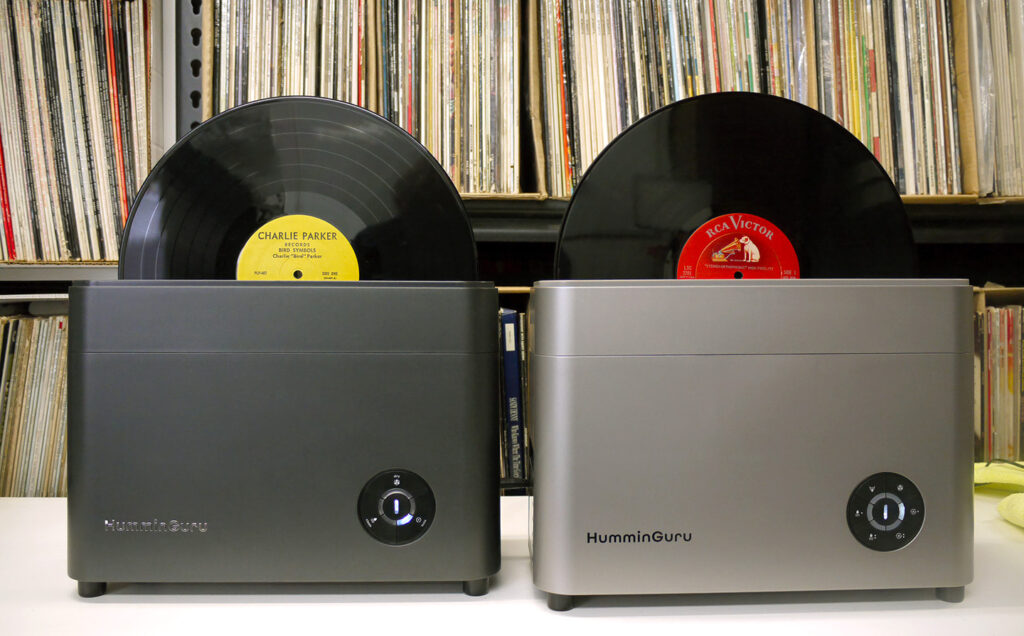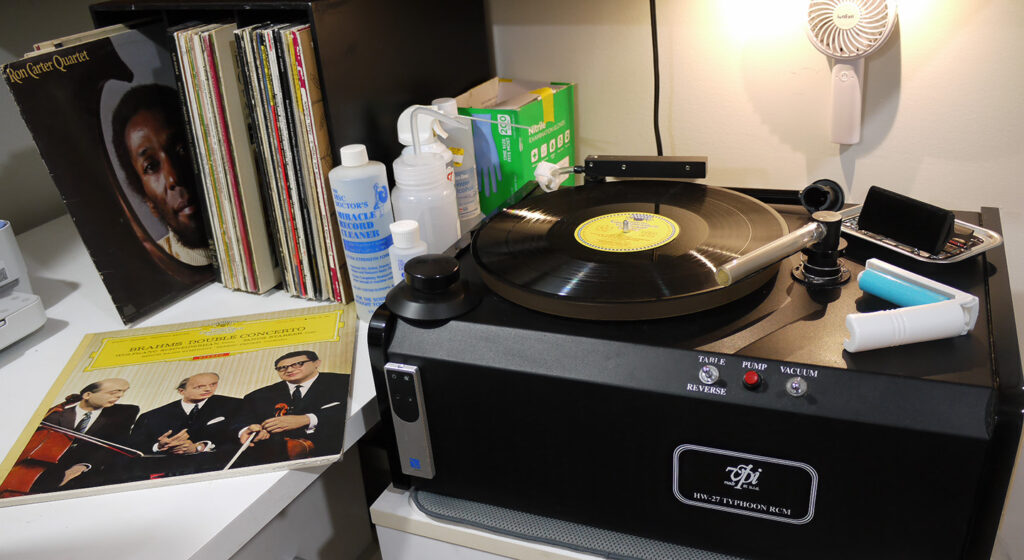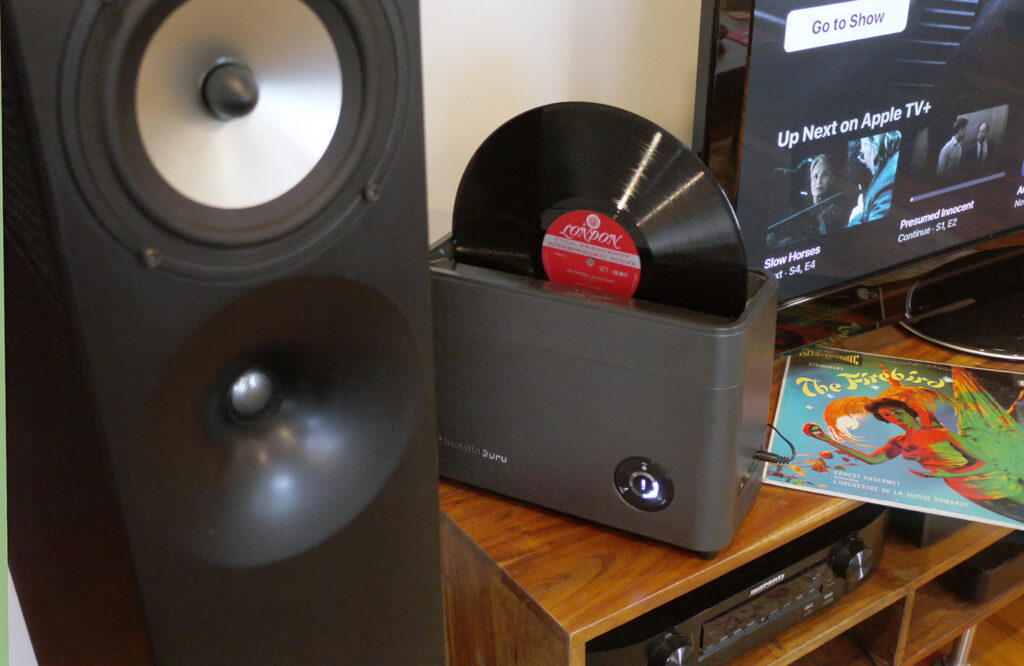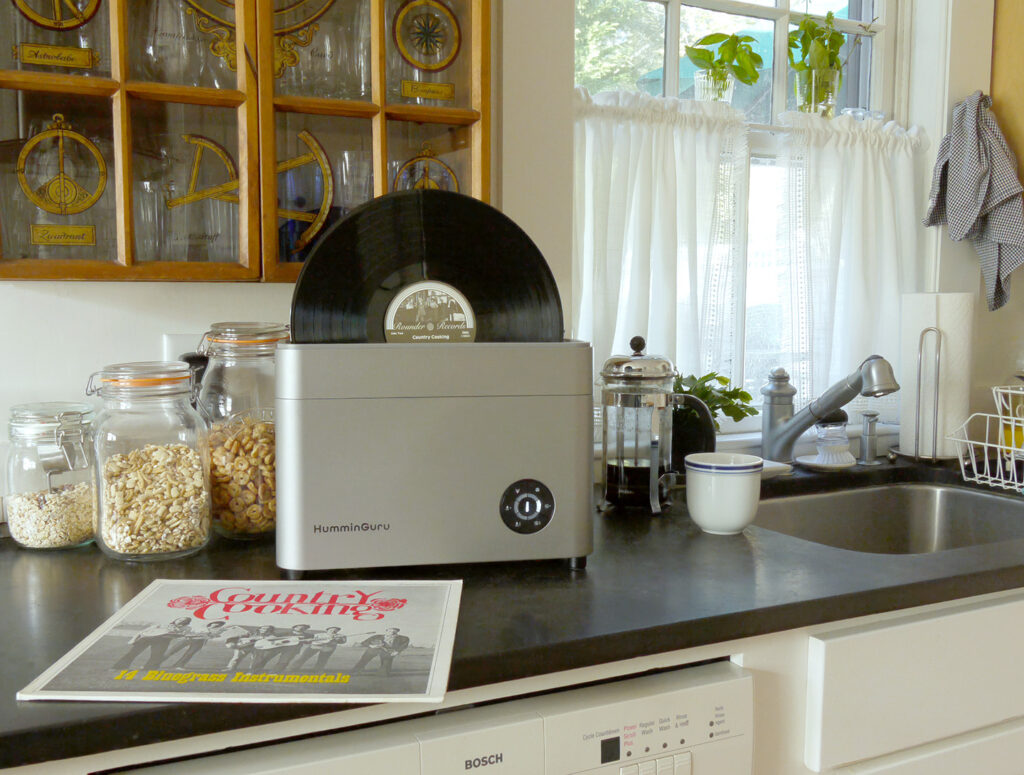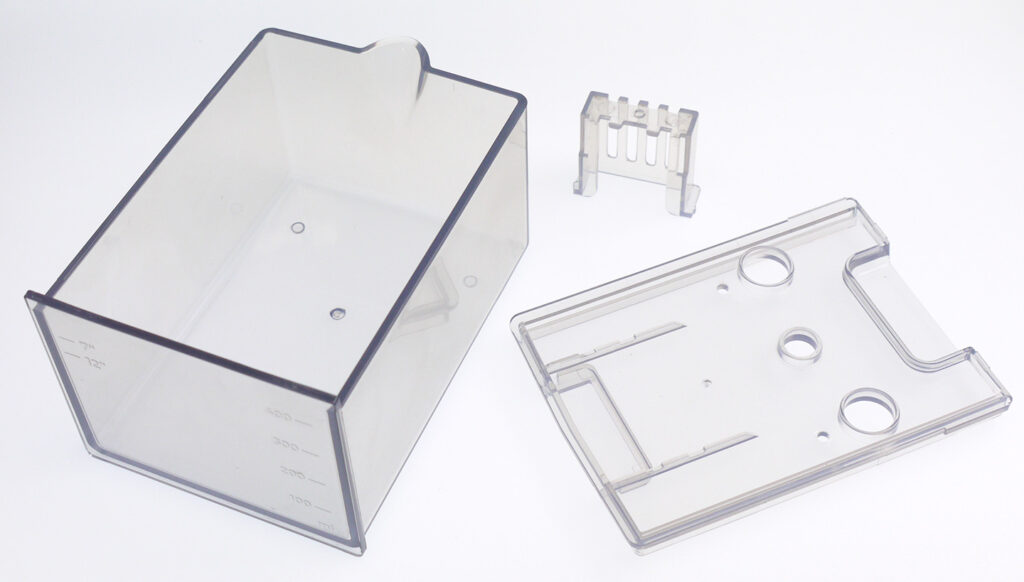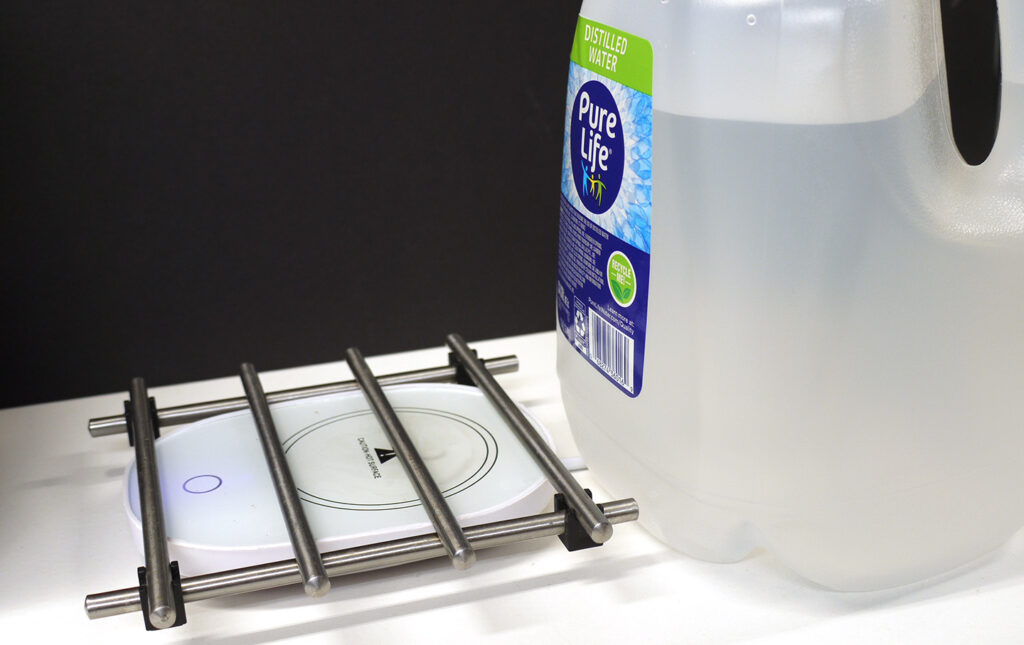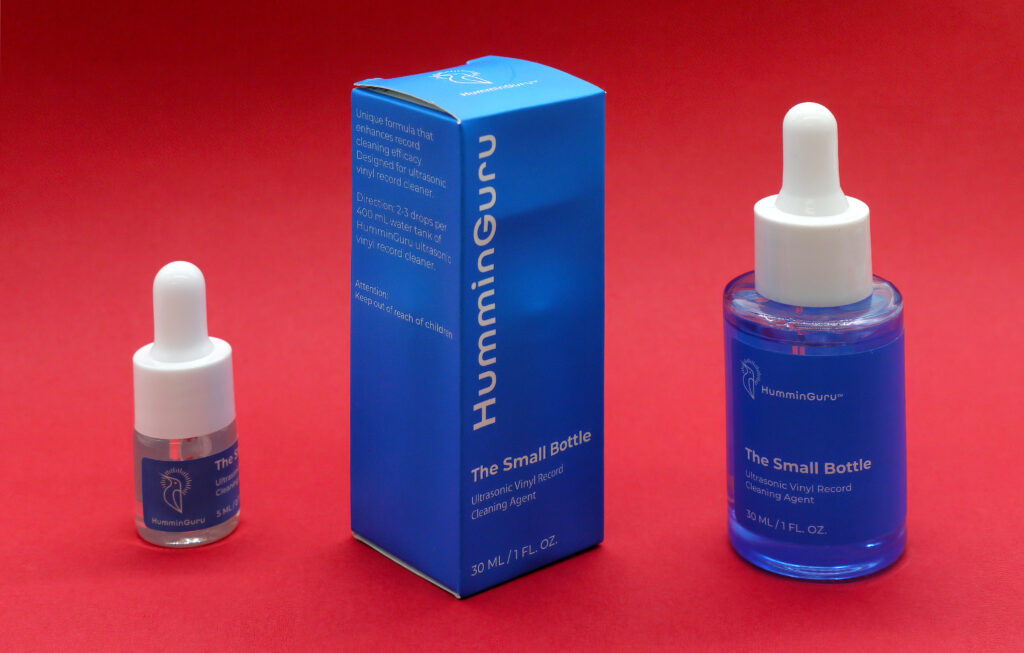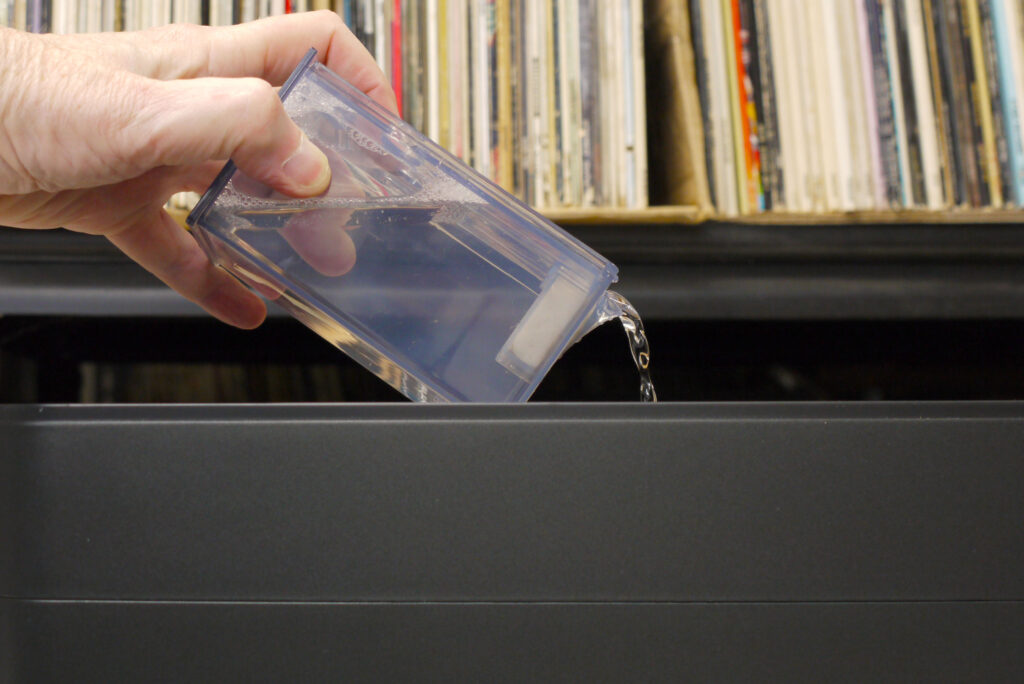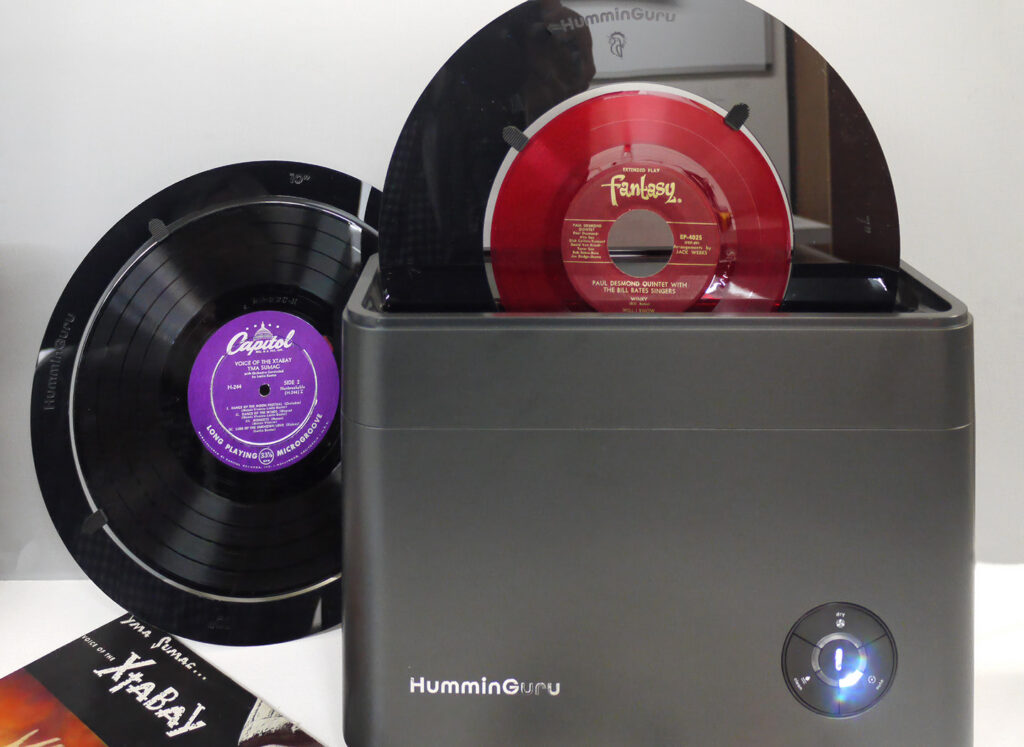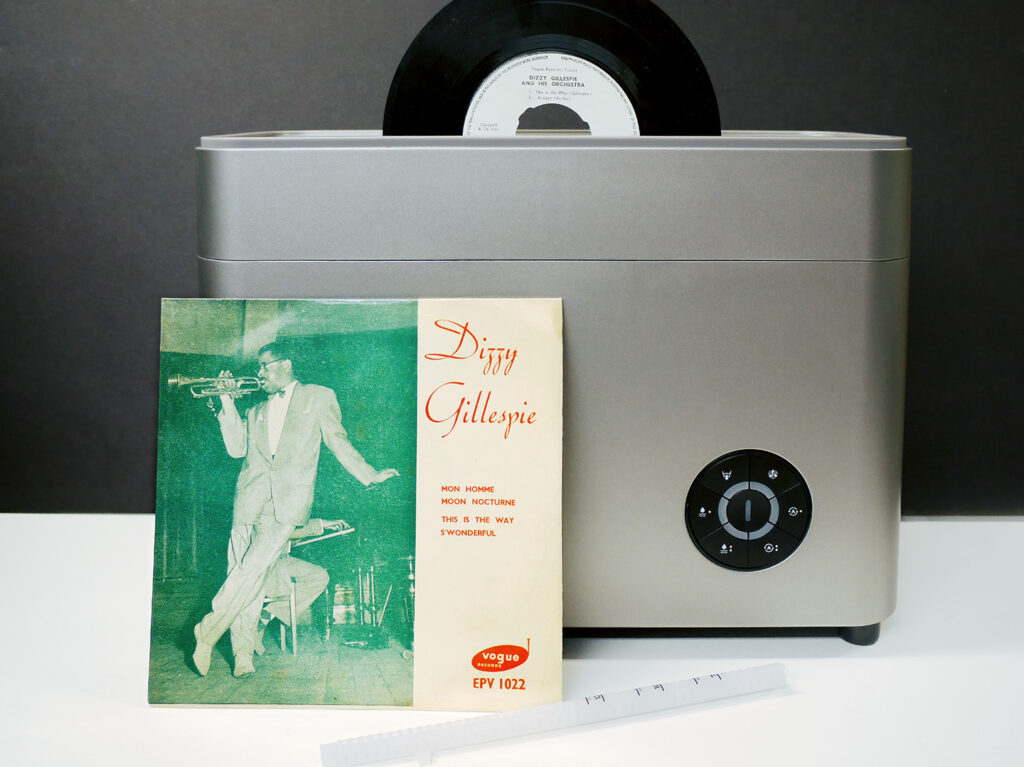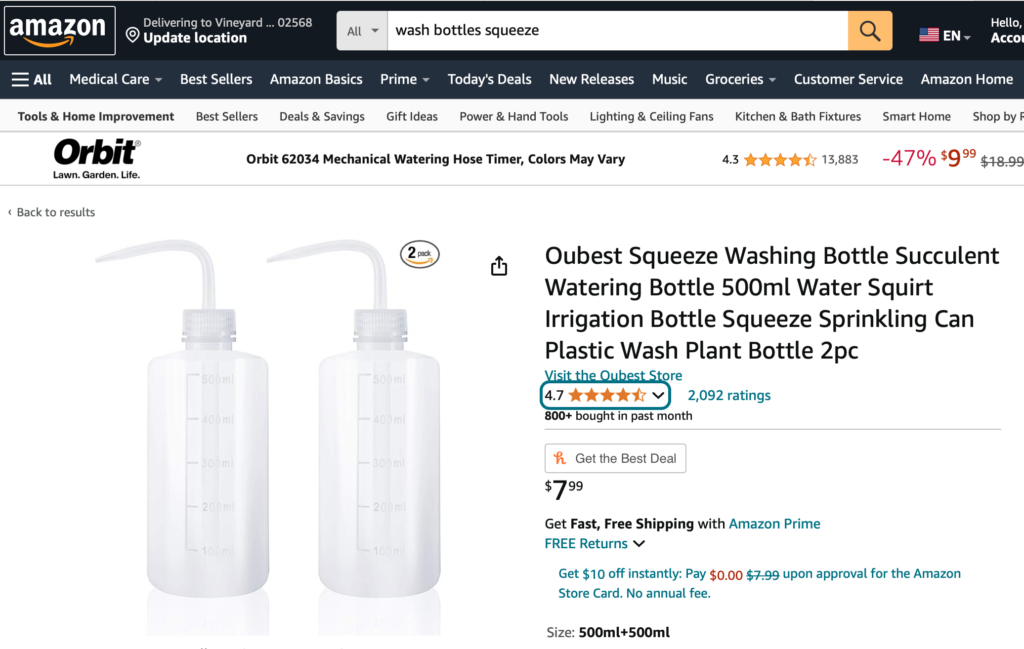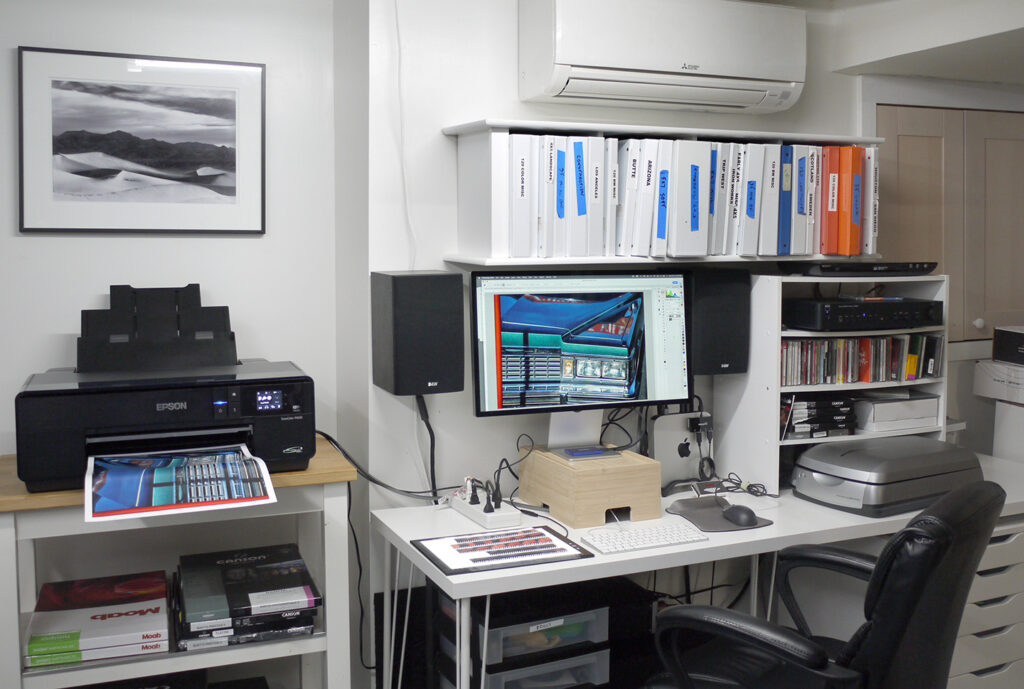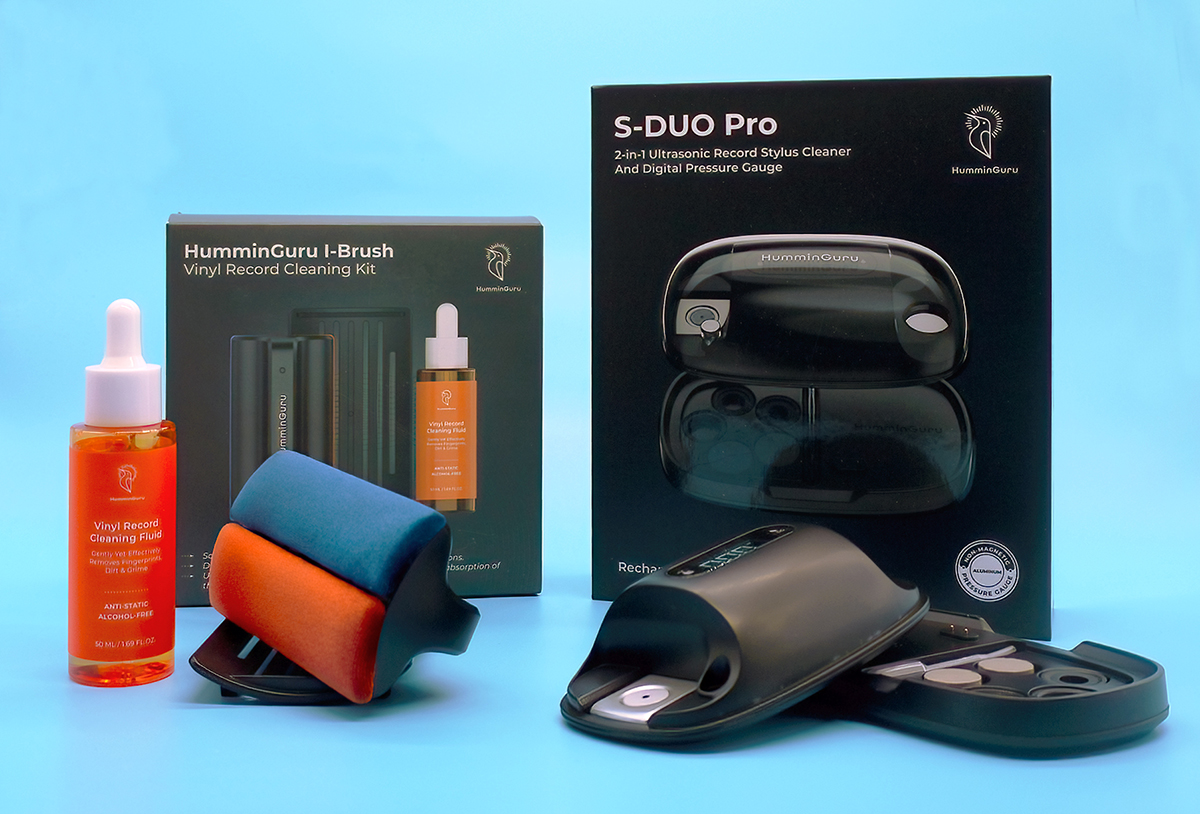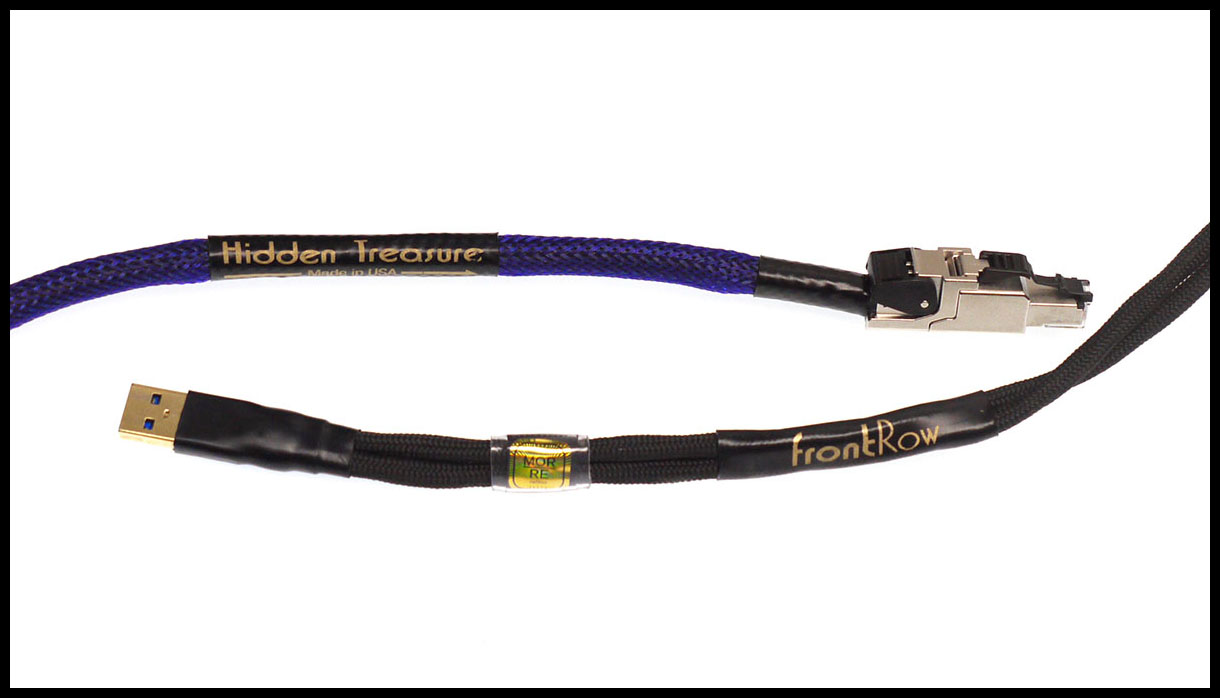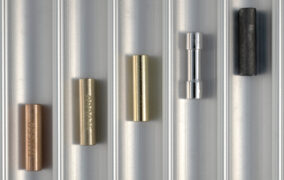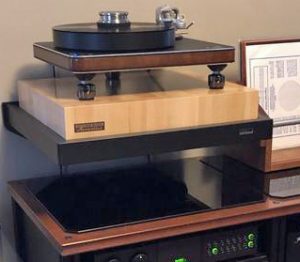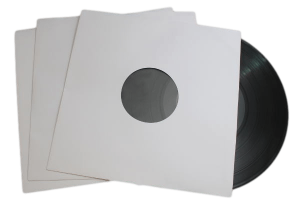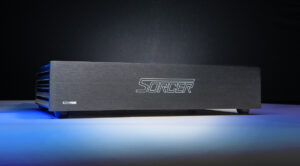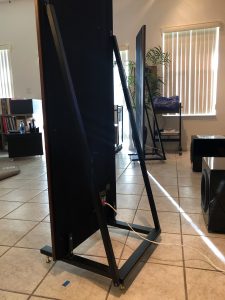HumminGuru? Just another Tik-Tok #influencer, you'd think? No, it turns out HumminGuru is a Hong Kong-based firm focused on accessories for vinyl enthusiasts, from LP inner sleeves to ultrasonic record cleaning machines. Two actually, both functionally similar to the high-end audiophile approved $4-6K machines, but currently going for as little as $379 and $699. Not a misprint, but it's complicated. Sorry.
You may not have heard of HumminGuru because, while they have stockists elsewhere around the globe, in the states it's Amazon-only at this time. In effect it's their US distributor/retailer (HERE), and thus higher prices there will reflect their mark-up, as well as the cost of "free" Prime shipping, their domestic return policy, and the occasional rocket launch.
Alternatively, consumers can order direct from the HumminGuru website (HERE), where the lower prices are "converted" to USD from Hong Kong dollars (and currently actually $379 and $699), and choose shipment via FedEx (delivery takes about 3-7 days) or SEA freight (about 15-30 days), plus any additional Customs delays. Any returns would also have to go to Hong Kong, or to a specific local warehouse location.
Okay, so many folks are leery of buying direct from China, while others refuse to buy anything from Amazon—as matters of principle or politics. Given those two options, they might not even consider a HumminGuru, at any price. Since I live on a small island, I've grown to depend on online and off-shore vendors for all sorts of things. The comfy shoes I'm wearing came direct from China last month, shipping took a week. While I appreciate the advantages of buying big-ticket items direct, I'd still suggest getting supplies, accessories, etc., through the on-line behemoth.
HumminGuru's logo is a needle-nosed hummingbird, but the name is just a conflation of the pleasures of humming + guru. Their rep explained "The brand strives to empower individuals to be the 'guru' of their lives, uncovering inner peace and fulfillment through an exploration of the world of vinyl music." Imagine all the people, and hum along.
I figure I've cleaned more than 10,000 records over the years. Unfortunately, I also have thousands more on the shelf that need attention. OK, many I might never play. Duplicates, yard-sale landfill specials, a few "inherited" from girlfriends long-gone, High Fidelity style. Most of the rest were acquired in used record shops, at estate or library sales, or from record shows over the decades.
I have plenty of bona-fide audiophile pressings, but not many of today's $50+ reissues. 50¢ is more my speed—I've always been a bottom-feeding record collector at heart: the endless search and the sudden thrill of discovery. Cleaning those LPs, however, has always been and remains a necessary chore.
The reality is that most purchasers of pre-CD era LPs were normal folk, not crazed audiophiles. They smoked (and inhaled), imbibed, partied, perspired, chomped pizza and other finger foods while playing their music, and with any luck ended up doing the nasty to their favorite make-out records on auto-repeat. If they cleaned their records at all, the best options of the day were "anti-static" cloths or brushes that mostly pushed the collected gunk further into the grooves.
A while back my esteemed editors republished my first ever contribution to Positive Feedback (from 1997, when it was a printed magazine HERE). Oddly enough, it was also about cleaning records: using the Disc Doctor's Miracle Record Cleaner fluid and brushes manually—without requiring one of those them there new-fangled vacuum record cleaning machines. I thought it worked even better with one, and I happily still use the stuff. (Acoustic Sounds sells the entire line, just search for Disc Doctor on their website (HERE).
Why refer to an ancient article for a review of modern ultrasonic record cleaners like the HumminGurus? It was this passing aside about manual cleaning, midway through: "While you clean records you can also listen to music, watch TV, the kids at play, or your neighbor mowing the lawn." But the truth is, no record cleaning system I've used ever since has let me do any of that. My VPI HW-16.5 was eventually replaced by the workhorse HW-27 Typhoon, I later cobbled together a DIY ultrasonic system similar to Rushton Paul's (HERE), and just in time for Covid, added a Kirmuss ultrasonic system for "restoring" rare collectibles—alas, with each contraption the process became more time and labor intensive.
Music remains a priority, I enjoy Netflix and the grand-kids' visits, but although somebody else does my lawn, I never seem to find the time for cleaning LPs. Perhaps because, as noted in that same piece, my record collecting life paralleled my photography career. As a result, I have thousands of unprinted negatives as well as thousands of unheard LPs in my workroom. Scanning, Photoshopping, and digitally printing decades-old analog images is as much a time and attention hog as record cleaning, and no more amenable to multitasking.
For example, even expensive vacuum record cleaning machines like my VPI simply suck up the user-applied cleaning fluids that actually do the dirty work, one side at a time—with the process repeated if an enzyme pre-wash or rinse is needed. It soon gets tedious, I have to wear noise-cancelling headphones or earplugs because of the noise, and everything is very hands-on and pay attention, please.
That's why ultrasonic cleaning first drew my attention. There have been a number of "ultrasonic record cleaning machines" out there (including the Kirmuss) which are adapted from commercial tanks designed for industrial/medical/dental applications. One just has to suspend and rotate the disc(s) in a bath of water (with perhaps added alcohol or surfactants). The ultrasonic energy causes "cavitation" micro-bubbles which very effectively clean the grooves. Of course it's then up to the user to improvise a scheme to dry the LPs without re-contamination. Again, adult supervision is advised.
Over the last decade or so a few purpose-built ultrasonic record cleaning machines have come to the audiophile market, each designed to integrate the cleaning/drying process. Insert a dirty disc, push a button and the machine does the rest. The wash and dry cycles are automated, much as they are for that dish-washing appliance in your kitchen. But those audiophile disc-washing appliances have been priced at several times the cost of a nice new Bosch dishwasher. This apparently presented occasional problems where non-audiophiles had input on household expenditures.
What prompted this dual review was the arrival of the HumminGuru Nova, an "advanced" version (Model HG05) of the the original (HG01). Though quite similar, there are differences which might influence buyers to choose one or the other. Therefore, I will go through the process of cleaning a 12" LP in some detail to note the differences, adding my own comments and user tips along the way.
The two models share size (13 x 9 x 6 in), packaging and many parts; the washing troughs are stainless steel, but the outer case and water tank are plastic rather than metal. This makes them more economical to produce and ship internationally (and at 6.5 and 7 lbs. it is light enough to easily move around the house, too).
The sturdy shipping box includes the well-protected unit and all the small bits (spare air and water filters, a multi-purpose adjustment tool, etc.). No assembly is required, and the comprehensive instruction booklet (in English here) is well illustrated. The HumminGurus are very easy to set up, but do read the manual first. It may be an appliance, but you can't just plug it in and add water.
The original model comes in Dark Grey; the Nova in White Sand. Their industrial design is sleek and modern but unobtrusive; they look as good next to other appliances on a kitchen counter or in a living room media center as in a dedicated listening room. Plus, they fit neatly on any LP-sized shelf when not in use.
Functional differences? My HG01's power supply came with a detachable 3' three prong IEC power cord and a captive 5' DC cable, straight plug; the HG05 came with a substantial 2 prong wall-wart with adapters for US and other nations' outlet styles and a 5' DC cable, 90˚ plug. Both provide 5A at 12V.
The water tank and filters appear to be identical, but the multi-purpose adjustment tools are somewhat different. The Nova's tool is used to adapt it for 10" and 7" records. For the original version, adapter discs for 7"or 10" discs are available if needed; Amazon offers a package that includes them with the machine.
The control layouts differ somewhat. On the right end of both machines are the DC input and power button, plus a slide switch that determines the drying time. For the original, the (unmarked) choice is 5 or 10 minutes; for the Nova just 3 or 6 minutes, thanks to a more powerful fan.
The round control panels on the front are also different. On the original there are three peach-slice "Mode" buttons surrounding a center start/pause/status button. On the lower right, the Auto button selects a combined Clean (selectable 2 or 5 minutes) + Dry cycle. The lower left Clean button selects washing only, the top Dry button drying only, plus draining the system for storage. Pressing the center button begins the selected Mode, and off you go.
The Nova control panel has six buttons adding flexibility to these Modes. The Auto 2 minute and Auto 5 (or optional 10) minute Clean + Dry cycle buttons are separate; other buttons provide 2 or 5 (optional 10) minute Clean only, Draining, and Dry only. Again, the center button initiates the chosen Mode.
OK, so we are now at the "Just add water" stage. But no tap water, please. The HumminGurus require distilled (or de-ionized or demineralized) water. Neither model pumps fluid into the wash basin–that is done manually for each disc—but the used fluid is automatically drained into a tank before drying the disc. The transparent drain tank is marked in ml, 400ml being the maximum; there are also indications for the optimum levels for 10-12" and 7" discs. The detachable filter holder allows easy inspection or change of the filter. The tank is easily filled directly by removing the lid.
Alternatively, one can use any clean graduated cylinder—400 ml is about 13.5 ounces, but that is a bit too much and may wet the rim of some wide labels. 375 ml (12.7 oz.) seems about ideal, and it means ten fill-ups per gallon of distilled water.
For both record cleaners, HumminGuru recommends using warm distilled water between 25˚C to 35˚C (75˚F to 95˚F) to enhance the surface tension effect needed for optimal cleaning results–but to avoid adding water over 95˚F at the beginning of a cleaning cycle. (The water temperature will slightly increase due to the nature of ultrasonic technology. )
However, here in New England, the fall/winter/spring temperature in my finished basement is usually below 70˚. Therefore I use a $7 Amazon cup warmer with an IKEA trivet (for added stability) under the water bottle—on a timer to prevent over-heating. The HumminGurus can also get warm under heavy use, and have an auto-shutoff sensor at about 130˚F, at which point the wash basin should be drained so the machine can cool down.
HumminGuru recommends 2-3 drops of their non-alcoholic low-foam surfactant per tank of water. That works out to 20-30 drops per gallon if you want to pre-mix. A 5 ml vial comes with the Nova; the standard Small Bottle (30ml/1 oz.) is available online—good for cleaning an estimated 1000 LPs. While it has proven effective in their machines, you are free to choose your own preferred additive. I'd suggest sticking to products specifically formulated for use in ultrasonic record cleaning machines, not for general ultrasonic cleaning or conventional LP cleaning rigs, and no corrosive or flammable fluids, please. Of course, the machines will also function well with plain distilled water.
Next step is to power up the machine, and pour the measured amount of fluid into the middle of the disc washing trough. The original model's entire top is a broad funnel. The Nova top is flat because the disc-size adjustment mechanism operates beneath it. A special flat funnel is included, although I see no reason a conventional funnel could not be used with either model. The lid of the drain tank is not locked, so keep a finger on it while pouring. Return the empty drain tank to its recess on the left end—the machines won't work without a tank in place.
The tank incorporates a white fibrous filter at the pouring spout, so one tank-fill can be re-used for multiple discs until the filter is discolored and soiled. Spare filters are included, and they can be rinsed and re-used; replacements can also be purchased online. Here's what a filter used to clean about 35 "average" LPs looks like.
Just how many discs should be cleaned per tank-fill is otherwise mostly a matter of when the level in the drain tank approaches 300 ml, as a bit gets evaporated with each disc. For consistency, I decided to do only 5 discs per tank-fill (i.e., 50 LPs per gallon of water), then to empty the tank into a bucket and wipe down the inside of the tank. Those who are more LP-OCD than me can use a fresh tank of water for each disc (10 LPs per gallon is still cheap).
Perhaps counter-intuitively, one should not just up and clean a really dirty disc. Any loose debris should be brushed off (HumminGuru makes a nice one), wiped up with a microfiber cloth, or snagged with a sticky lint roller. There is a filter (actually a screen) at the bottom of the trough designed to trap pet hair, dead insects, or whatever weird stuff detaches from the vinyl. This filter can be removed for cleaning with the multi-purpose tool. The air intake filter is under the power button end, and can be changed without a tool.
OK, we are now ready to insert the LP into the machine, making sure it is seated in the slots at both ends of the trough and the central support above the bottom filter. Select a Clean mode, press the start/pause central button, and the disc will slowly rotate counter-clockwise, in and out of the fluid. The HumminGurus are much quieter than vacuum-style cleaners, but they are not silent and sound slightly different, but our microwave seems louder. The LEDs on the Nova light up sequentially to monitor progress, but neither unit provides an audible signal upon completion. I just use a cheap kitchen timer.
At the end of an Auto Clean the fluid drains into the tank, and the Dry mode commences. The Nova's more powerful fan speeds up the process, but humidity can affect drying times. The island humidity is often above 70% and the longer times (6 or 10 minutes) were needed with both units in that situation. Of course one can extend the drying time with either model, but the Nova's Dry only mode option conveniently avoids the original's 40-second drain sequence delay before resuming drying.
The Nova has one other cute trick. The lid on the original is just a dust cap. The newer model's lid is molded with grooves and holes to accept some supplied tubes with little rubber hummingbird caps to prevent scratching. They can be used to organize several discs or jackets, but I just use them to hold up the jacket of the LP being cleaned. The lid is still a lid: the inverted tubes fit neatly into the water trough.
I may have made the process seem more complicated than it is—the safety info on page two of the manual states that children age eight and older can safely use the machines if properly supervised. Sure, but maybe not during that phase when They Just Don't Listen.
I don't know if or when the Nova will come to replace the original HG01, but while both are available, last year's model looks like a bargain. Why not just buy one, and get your non-audiophile budget manager a nice little bauble?
First, for some users, size matters—the biggest mechanical difference is how the machines adapt to 10" and 7" discs. Like several pricey "audiophile" machines, the original requires purchasing adapter discs into which the smaller discs are fitted with little rubber clips.
On the Nova, one first uses the multi-purpose tool to snap in a guide of the appropriate height over the drain filter. Then the tool is inserted into a hole on the top, and twisted to move the guide wheels to the proper spacing index point. How cool is that?
Not complicated, just a bit fiddly the first time. However, should you want to clean a stack of 7" 45s, the Nova system will make the task a lot faster than individually adapting every disc.
Second, if you are a fan of filthy first pressing 50s-60s vintage vinyl like myself, the Nova's dual ultrasonic transducers and wash time flexibility are not the only plus factor. The separate manual Drain mode button facilitates using a second wash or rinse in fresh solution without drying the disc. For example, one might begin cleaning with an enzyme solution, drain it to the tank, pause the process to dump and replace the tank, then simply use a "wash bottle" to squirt the surfactant fluid into the trough (avoiding the label, of course), and proceed.
Oops, I just went and made it complicated again. My bad.
Obviously, for heavy users like record stores, on-line sellers, radio stations, and DJs, the wash options and shorter dry times of the Nova will increase throughput. Just as importantly, the Nova's greater power, flexibility, and capabilities make it much more attractive to analog-oriented audiophiles—and compared to the high-end competition, practically a steal.
Who then does that leave to snap up the original HG01? That version still neatly addresses the needs of listeners who buy only new release 12" vinyl, those for whom vinyl is only a portion of their listening regimen, the many older audiophiles with a crate or two of albums in the basement they'd like to revisit without a lot of aggravation, younger folk just getting into vinyl, and those who want to pre-clean discs before converting their music to digital files.
Overall, I also suspect that for many folks who already have record cleaning equipment–a manual Spin Clean, older vacuum systems or clunky DIY ultrasonics—the appeal of HumminGuru's affordable, automated "labor-saving appliances" cannot be be disregarded.
So how well do they work? Quite well, actually; the results for routine 2 minute washing of "clean" used LPs with either model seem equally effective—often "good as new." In fact, it is well worth taking new LPs—especially those in paper inner sleeves—for a spin. The beauty of ultrasonic cleaning is that cavitation bubbles scour the finest grooves much better than any brush, and without added physical contact. The benefits are easily heard—even in the lead-in groove—as a quieter noise floor, plus superior high frequency resolution, better tracking, and much less gunk build-up on the stylus.
Less than pristine discs confirmed the benefit a 5 minute Clean, and here the dual-transducer Nova clearly had the advantage. The 10 minute Clean option of the Nova is there for truly scuzzy LPs, but I didn't really need it very often. Nor did I experiment with different amounts of surfactant, or any alternative additives.
In my experience, ultrasonic cleaning is at its absolute best for extracting nano-particulate material from the grooves—as well as overall environmental grime and recent fingerprints. 50 year-old fingerprints, other really stubborn organic or "chemical" residue like the swirly deposits from early plastic inner sleeves or pressing "mold release" compounds can benefit from vacuum cleaning systems where problem-specific enzyme, chemical, or alcohol-based options can be more effective. Likewise the time and labor intensive Kirmuss system. But frankly, I found using the hands-free HumminGurus first has greatly reduced any urge for more extreme measures upon audition.
Are they as good as the high-end ultrasonic competition? I can't say, as I don't have any here to directly compare-nor can I say that any of those are a better investment than 6 to 10 HumminGurus all in a row. What seems most important is that convenient, affordable, all-in-one ultrasonic vinyl cleaning is now available to a much broader swath of the record-playing public.
Finally, I must also report that I can now merrily multi-task for hours on end, stepping away from the computer at regular intervals to effortlessly clean another disc, then return refreshed to resurrect yet another image. Easier on my eyes, easier on my ears, and more productive all around.
Highly recommended!
Ultrasonic Vinyl Record Cleaner
Retail: $379/$499
NOVA Advanced Ultrasonic Vinyl Record Cleaner
Retail: $699/$799
HumminGuru




